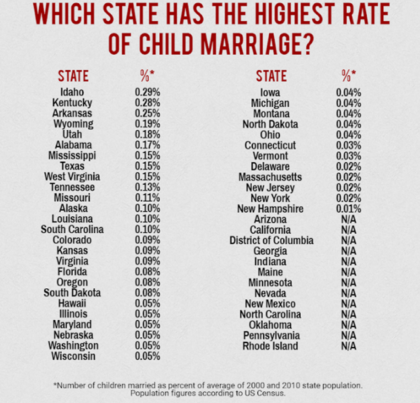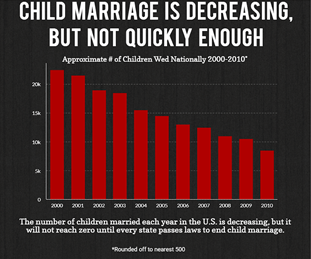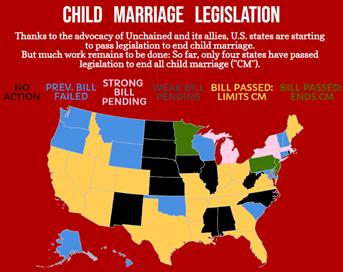Written by: Ingrid Naumann
Some 248,000 children as young as 12 were married in the U.S. between 2000 and 2010.
Actual data from 38 states showed more than 167,000 children wed in that decade. The other 12 states and Washington, D.C., could not provide the data. An overwhelming majority of the children married were girls.
Children can easily be forced to marry or to stay in a marriage before they turn 18, because they have limited legal rights. Further, marriage before 18 produces such devastating, lifelong repercussions for girls that the U.S. State Department has called it a “human rights abuse.”
Most of these girls were married to adult men. These were not “Romeo and Juliet” situations. Some 77% of the children wed were minor girls married to adult men, often with significant age differences. Some children were wed at an age, or with a spousal age difference, that constitutes statutory rape under their state’s laws.
Child Marriage by State
Only four states have made child marriage illegal. Pennsylvania has outlawed child marriage, following laws passed in Delaware and New Jersey in 2018. In May, 2020, Minnesota ended child marriage.
Child marriage remains legal in 46 states.
Do you know how many children were married in your state between 2000 and 2010? How young were they? Or is your state one of those that do not even track that data?
Many states gave an age range for the youngest children married, such as “14 or younger.” Just how much younger were the child brides and grooms?


Effect of Covid-19 on Child Marriage around the World
The pandemic is increasing poverty – forcing girls out of school and into work or marriage, the charity Save the Children has warned.
An estimated 500,000 more girls worldwide risk being forced into child marriage and as many as one million more are expected to become pregnant in 2020 as a result of the economic impacts of the COVID-19 pandemic, new analysis from Save the Children reveals—a year-over-year increase of four and three per cent, respectively.
The increase comes on top of the previous estimated rates of child marriage, which already anticipated 12 million girls around the world being forced into marriage this year. While this increase represents a conservative estimate, it marks a significant surge in child marriage rates with an expected spike in teenage pregnancies and school dropouts to follow. The increase is set to reverse 25 years of progress, which saw child marriage rates decline.
In its new report “Global Girlhood 2020: COVID-19 and progress in peril,” Save the Children analyzed the impact of COVID-19 on gender equality, revealing its devastating effects.
Up to 2.5 million additional girls are expected to marry over the next five years. Together with the 58.4 million child marriages taking place on average every five years, this amounts to a staggering 61 million child marriages by 2025.
Immigration and Child Marriage in the U.S.
The phenomenon occurs in the U.S. as well. Thousands of requests by men to bring in child and adolescent brides to live in the United States were approved over the past decade, according to government data obtained by The Associated Press (January 2019). In one case, a 49-year-old man applied for admission for a 15-year-old girl.
The approvals are legal: The Immigration and Nationality Act does not set minimum age requirements for the person making the request or for that person’s spouse or fiancée. By contrast, to bring in a parent from overseas, a petitioner has to be at least 21 years old.
And in weighing petitions, U.S. Citizenship and Immigration Services goes by whether the marriage is legal in the spouse or fiancée’s home country and then whether the marriage would be legal in the state where the petitioner lives.
The data raises questions about whether the U.S. immigration system may be enabling forced marriage and about how U.S. laws may be compounding the problem despite efforts to limit child and forced marriage.
Forced Marriage
In a forced marriage, one or both parties enter without full, free consent. Further, even if both parties enter a marriage with full, free consent, the union can later become a forced marriage if one or both parties is forced to stay in it.
Forced marriage is a human rights abuse, according to the U.S. State Department. Forced marriage is also recognized by the International Labor Organization as a form of modern slavery.
Forced marriage often means a lifetime of rape, abuse and domestic servitude, and the loss of reproductive rights, financial rights and basic human rights. For women and girls, forced marriage often means forced motherhood.
Is “Arranged” different from “Forced?”
The difference between an arranged marriage and a forced marriage is supposed to be the difference between consent and coercion. In an arranged marriage, both the bride and the groom consent to have their marriage arranged (with varying degrees of choice about when and whom to wed); in a forced marriage, one or both of them is coerced into the marriage and does not give full, free consent.
However, there is a fine line between consent and coercion. Even when a marriage is labeled “arranged” and the bride and groom get the option to say no, they might face intense pressure from their families and society not to do so, or they might be too young and inexperienced to make such a life-altering decision. They might be rushed to give an answer, before they can fully think through their options. They might be bribed or tricked. They might be grappling with implicit and/or explicit threats about the harms that will befall them and their families if they do not agree to a marriage. They might be subjected to actual violence: locked up, beaten or shunned until they say yes.
Unchained At Last was the first organization in the U.S. to recognize that “arranged” and “forced” often are indistinguishable. Some organizations are careful to separate the two terms — and to label “arranged marriage” as benign and “forced marriage” as evil — so as not to alienate or offend the people and communities that have been practicing “arranged marriage” for centuries.
However, Unchained, which was founded and is led by arranged/forced marriage survivors, understands the dangerous message such a dichotomy might send to women, girls and others who are pressured, bribed or tricked into marriage but do not face explicit threats or endure actual violence. Such individuals need to know what is happening to them is not “benign,” and they deserve and can get help.
How common is it in the U.S.?
Few studies have been done about arranged/forced marriage in the U.S., so exact statistics are unknown. A 2011 survey by the Tahirih Justice Center found 3,000 known or suspected cases in the previous two years alone of girls in the U.S. as young as 15 who were forced to marry under threats of death, beatings or ostracism.
Based on that study, and based on the size of the various communities in the U.S. that are known to practice arranged/forced marriage (various Orthodox Jewish, Muslim, Mormon, Sikh, Asian, African, Hmong and other communities), Unchained estimates that hundreds of thousands of women, girls and others in the U.S. are in arranged/forced marriages.
Why do women need help?
A woman or girl who tries to resist an arranged/forced marriage often risks ostracism and honor violence.
And a woman or girl who tries to get divorced after an arranged/forced marriage has happened usually faces serious obstacles. Typically, she is stymied by religious laws and social customs that make divorce difficult, especially for women. Often, she is shunned by her family and friends, who view divorce as shameful. If she was brought to the U.S. as part of an arranged/forced marriage, she might be constrained, as well, by her own immigration status.
Are men affected too?
Arranged/forced marriage affects boys and men too. However, women and girls are more likely than men and boys to be coerced into marriage, and they face additional, significant challenges — in the form of religious laws and social customs — when trying to resist or leave it.
For example, a woman in the Orthodox Jewish community does not have the legal right to divorce her husband; only men have the right to grant a divorce under Orthodox Jewish law. Further, most communities that practice arranged/forced marriage view divorce as shameful, and they tend to place the burden largely on women to avoid that shame and keep a marriage intact, even when that means women must sacrifice their safety or happiness.
Unchained At Last is the only nonprofit in the U.S. dedicated to helping women, girls and others resist or leave arranged/forced marriages. Unchained provides free legal and social services and emotional support, and Unchained raises awareness about arranged/forced marriage and advocates for relevant legislation to protect women, girls and others.
What can we do?
Educate Girls
Education plays a critical role in keeping girls safe from child marriage. In fact, the longer a girl stays in school, the less likely she is to be married before age 18 and have children during her teenage years.
In addition, education ensures girls acquire the skills and knowledge to find employment and a means to support their families. This can help break the cycle of poverty and prevent child marriages that occur as a result of extreme poverty and/or financial gain.
Empower Girls
Every girl has the right to decide her own future, but not every girl knows this – that’s why empowering girls is so crucial to ending child marriage.
When girls are confident in their abilities, armed with knowledge of their rights and supported by peer groups of other empowered girls, they are able to stand up and say “NO” to injustices like child marriage.
Empowered girls are able to re-shape perspectives and challenge conventional norms of what it means to be a girl.
Rally the wider community to stand up for girl’s rights
Parents and community leaders are often responsible for deciding when and whom a girl marries. In many traditional communities, it’s believed that marriage keeps girls safe, protected and economically provided for by their husbands.
However, the opposite is true – marriage endangers girls’ physical and mental health. In fact, girls who are married before 18 are more likely to experience domestic abuse and to report that their first sexual experience was forced. Furthermore, child brides are more at risk of HIV infection and more likely to experience deadly complications during pregnancy and childbirth.
When parents and community leaders are educated about the many negative consequences of child marriage, it can inspire them to change their views, speak up for girls’ rights and encourage others to do the same.
Álida, Rosy, Mayra and their friends were part of a successful Plan International campaign to raise the minimum age for marriage in Guatemala to 18 years. Together, they spread awareness, rallied their communities and petitioned lawmakers.
Provide girls and their families with income opportunities
Providing families with livelihood opportunities like microfinance loans is an effective way to prevent child marriages that occur as a result of financial need.
When families have increased economic opportunities, they’re less likely to perceive their daughters as economic burdens. This is especially true if a girl is in school gaining valuable skills that will help generate income in the future.
Petition government and encouraging supportive laws
In countries where child marriage is prevalent, petitioning government to increase the minimum age for marriage to 18 years is a critical first step for positive change.
Once the minimum age is increased, it’s imperative to continue raising awareness of these laws among government officials and community leaders to ensure the laws are being enforced.
Other legal policies, such as registering birth certificates and marriages, are powerful tools for preventing child marriage.
In the U.S.
U.S. states are beginning to pass legislation to end child marriage. But much work remains to be done: So far, only four states have passed legislation to end all child marriage.

In Washington state, you must be at least 17 to get married — 18 to marry without parental consent — but minors under the age of 17 may obtain a license after petitioning the court in “special circumstances.” While the statute does not list these special circumstances, typically they include pregnancy or childbirth.
Eliminate VISA loopholes that allow child marriage in the U.S.
Federal bills S.742/HR1738 would eliminate major visa loopholes that have allowed thousands of minors to be subjected to child marriages through our immigration system.
Contact your federal lawmakers in both the U.S. House of Representatives and Senate and urge them to support these bills. Visit this link to take action:
https://www.theahafoundation.org/advocacy-4/#federal-legislation
Sources:
Child Marriage; Unchained at Last, 2020; Child Marriage in the U.S; https://www.unchainedatlast.org/child-marriage-shocking-statistics/
Forced Marriage: https://www.unchainedatlast.org/about-arranged-forced-marriage/
Global Effective of Covid-19 on Child Marriage – OCHA / ReliefWeb, 10/1/2020
https://reliefweb.int/report/world/covid-19-places-half-million-more-girls-risk-child-marriage-2020?fbclid=IwAR0PjQjvDrFFtiFhB6QQrP2Iihd7oxbJx6Qj8BFjKN2vCNehsBzoxbbc75k
BBC, 10/1/2020 https://www.facebook.com/bbcnews/posts/10158198799732217
Immigration and Child Marriage, AP, 1/11/2019 – https://www.facebook.com/APNews/posts/10156095309566623
A4W News Group
Editing contributors/collaborators:
Jinwon Kim | Karen Keenan | Vicki Roberts-Gassler | Mary Ann Kirkpatrick
